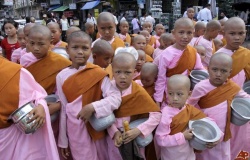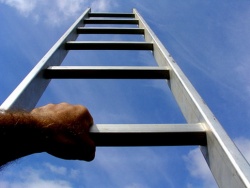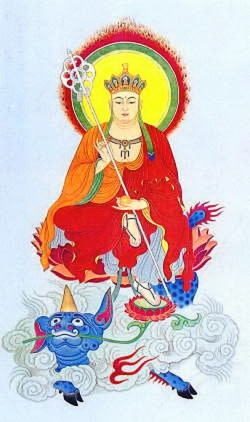Conditions for the Four Stages of Nibbana
The following Table shows the conditions to be fulfilled (i.e., factors to be eliminated) to attain each stage of Nibbana. For example, in order to attain the Sotapanna stage, three of the ten sanyojana are removed, akusala citta #1, 2, 5, 6, and 11 are removed with the apayagami strength in the other cittas also removed, etc.
| Sanyojana | Akusala Citta | Anusaya | Asava (Asaya) | |
|---|---|---|---|---|
| Sotapanna | saccaya ditthi |
1,2,5,6,11 Also removes apayagami strength in the rest |
ditthi |
ditthasava |
| Sakadagami | kama raga (reduced) patigha (reduced) |
weakens 9, 10 also weakens kama raga in 3,4,7,8 |
kama raga (reduced) patigha (reduced) |
kamasava (reduced) |
| Anagami | kamaraga |
9,10 also removes kama raga in 3,4,7,8 |
kamaraga |
kamasava |
| Arahant | rupa raga |
3,4,7,8,12 (see below for a list of akusala citta) |
mana |
bhavasava |
The 12 types of akusala citta are listed in, “Akusala Citta and Akusala Vipaka Citta“. But I thought it would be more explanatory to list them. The numbers below correspond to the numbers in the Table.
1. Citta connected with wrong view, accompanied by pleasure, and done with habit.
2. Citta connected with wrong view, accompanied by pleasure, and done reluctantly.
3. Citta NOT connected with wrong view, accompanied by pleasure, and done with habit.
4. Citta NOT connected with wrong view, accompanied by pleasure, and done reluctantly.
5. Citta connected with wrong view, accompanied by neutral mind, and done with habit.
6. Citta connected with wrong view, accompanied by neutral mind, and done reluctantly.
7. Citta NOT connected with wrong view, accompanied by neutral mind, and done with habit.
8. Citta NOT connected with wrong view, accompanied by neutral mind, and done reluctantly.
9. Citta associated with hate, accompanied by displeasure, done with habit.
10. Citta associated with hate, accompanied by displeasure, done reluctantly.
- Moha Citta (only with the moha root)
11. Citta accompanied by neutral mind, associated with vicikicca (not aware of bad consequences)
12. Citta accompanied by neutral mind, associated with uddacca (unfocused).
Notes:
1. Even though recent Abhidhamma literature categorize lobha and dosa citta as asankharika (unprompted) and sasankharika (prompted), in original Abhidhamma, they were not categorized as such.
2. For example, the two dosa-mula cittas are:
- Domanassa sahagata patigha-sampayutta citta.
- Domanassa sahagata sasankharika patigha-sampayutta citta.
- The first citta arises due to sansaric habits and thus are more potent. For example, someone who has a tendency to flare-up, normally generates such potent citta.
- On the other hand, another person without such a habit, may not generate such a citta unless “forced hard”; it is done with reluctance, “when pushed to the limit”.



